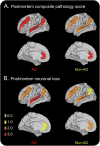Clinical marker for Alzheimer disease pathology in logopenic primary progressive aphasia
- PMID: 28515265
- PMCID: PMC5567322
- DOI: 10.1212/WNL.0000000000004034
Clinical marker for Alzheimer disease pathology in logopenic primary progressive aphasia
Abstract
Objective: To determine whether logopenic features of phonologic loop dysfunction reflect Alzheimer disease (AD) neuropathology in primary progressive aphasia (PPA).
Methods: We performed a retrospective case-control study of 34 patients with PPA with available autopsy tissue. We compared baseline and longitudinal clinical features in patients with primary AD neuropathology to those with primary non-AD pathologies. We analyzed regional neuroanatomic disease burden in pathology-defined groups using postmortem neuropathologic data.
Results: A total of 19/34 patients had primary AD pathology and 15/34 had non-AD pathology (13 frontotemporal lobar degeneration, 2 Lewy body disease). A total of 16/19 (84%) patients with AD had a logopenic spectrum phenotype; 5 met published criteria for the logopenic variant (lvPPA), 8 had additional grammatical or semantic deficits (lvPPA+), and 3 had relatively preserved sentence repetition (lvPPA-). Sentence repetition was impaired in 68% of patients with PPA with AD pathology; forward digit span (DF) was impaired in 90%, substantially higher than in non-AD PPA (33%, p < 0.01). Lexical retrieval difficulty was common in all patients with PPA and did not discriminate between groups. Compared to non-AD, PPA with AD pathology had elevated microscopic neurodegenerative pathology in the superior/midtemporal gyrus, angular gyrus, and midfrontal cortex (p < 0.01). Low DF scores correlated with high microscopic pathologic burden in superior/midtemporal and angular gyri (p ≤ 0.03).
Conclusions: Phonologic loop dysfunction is a central feature of AD-associated PPA and specifically correlates with temporoparietal neurodegeneration. Quantitative measures of phonologic loop function, combined with modified clinical lvPPA criteria, may help discriminate AD-associated PPA.
© 2017 American Academy of Neurology.
Figures


Comment in
-
Beyond clinical syndromes in primary progressive aphasia: Seeking etiologic diagnoses.Neurology. 2017 Jun 13;88(24):2244-2245. doi: 10.1212/WNL.0000000000004041. Epub 2017 May 17. Neurology. 2017. PMID: 28515274 No abstract available.
Similar articles
-
Primary Progressive Aphasia Lacking Core Features of Nonfluent and Semantic Variants: Clinical, Neuroimaging, and Neuropathologic Features.Neurology. 2024 Nov 12;103(9):e209924. doi: 10.1212/WNL.0000000000209924. Epub 2024 Oct 8. Neurology. 2024. PMID: 39656512
-
Heterogeneous Language Profiles in Patients with Primary Progressive Aphasia due to Alzheimer's Disease.J Alzheimers Dis. 2016;51(2):581-90. doi: 10.3233/JAD-150812. J Alzheimers Dis. 2016. PMID: 26890751
-
Common and divergent neural correlates of anomia in amnestic and logopenic presentations of Alzheimer's disease.Cortex. 2017 Jan;86:45-54. doi: 10.1016/j.cortex.2016.10.019. Epub 2016 Nov 5. Cortex. 2017. PMID: 27875715
-
Primary progressive aphasia and Alzheimer's disease: brief history, recent evidence.Curr Neurol Neurosci Rep. 2012 Dec;12(6):709-14. doi: 10.1007/s11910-012-0307-2. Curr Neurol Neurosci Rep. 2012. PMID: 22932755 Review.
-
Primary progressive aphasia and the evolving neurology of the language network.Nat Rev Neurol. 2014 Oct;10(10):554-69. doi: 10.1038/nrneurol.2014.159. Epub 2014 Sep 2. Nat Rev Neurol. 2014. PMID: 25179257 Free PMC article. Review.
Cited by
-
Lewy Body Disease is a Contributor to Logopenic Progressive Aphasia Phenotype.Ann Neurol. 2021 Mar;89(3):520-533. doi: 10.1002/ana.25979. Epub 2020 Dec 17. Ann Neurol. 2021. PMID: 33274526 Free PMC article.
-
Neurofilament Light Chain Related to Longitudinal Decline in Frontotemporal Lobar Degeneration.Neurol Clin Pract. 2021 Apr;11(2):105-116. doi: 10.1212/CPJ.0000000000000959. Neurol Clin Pract. 2021. PMID: 33842063 Free PMC article.
-
The atrophy pattern in Alzheimer-related PPA is more widespread than that of the frontotemporal lobar degeneration associated variants.Neuroimage Clin. 2019;24:101994. doi: 10.1016/j.nicl.2019.101994. Epub 2019 Aug 25. Neuroimage Clin. 2019. PMID: 31505368 Free PMC article.
-
Early-onset Alzheimer Disease and Its Variants.Continuum (Minneap Minn). 2019 Feb;25(1):34-51. doi: 10.1212/CON.0000000000000687. Continuum (Minneap Minn). 2019. PMID: 30707186 Free PMC article. Review.
-
A longitudinal study of speech production in primary progressive aphasia and behavioral variant frontotemporal dementia.Brain Lang. 2019 Jul;194:46-57. doi: 10.1016/j.bandl.2019.04.006. Epub 2019 May 7. Brain Lang. 2019. PMID: 31075725 Free PMC article.
References
-
- Mesulam MM. Slowly progressive aphasia without generalized dementia. Ann Neurol 1982;11:592–598. - PubMed
MeSH terms
Grants and funding
LinkOut - more resources
Full Text Sources
Other Literature Sources
Medical
Miscellaneous
